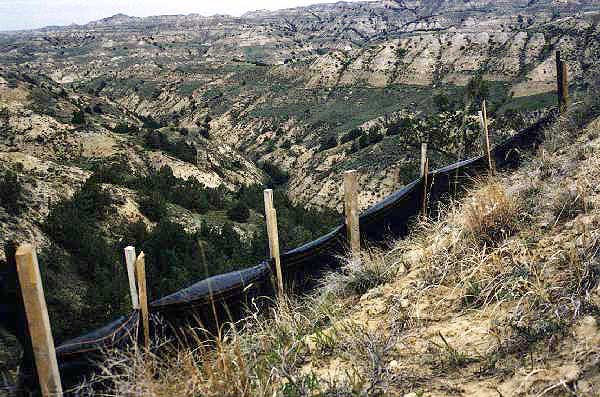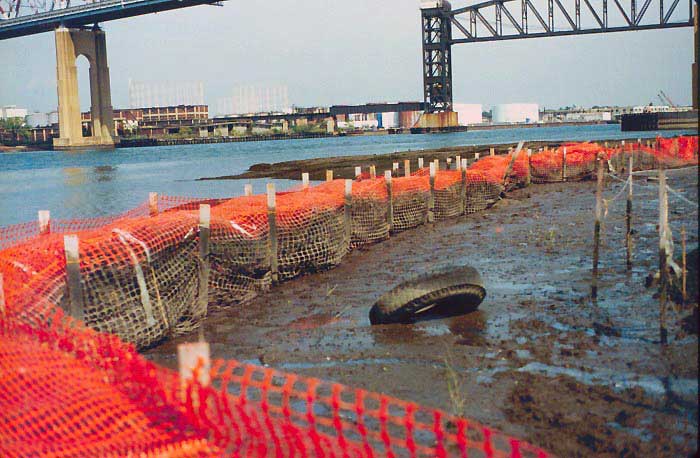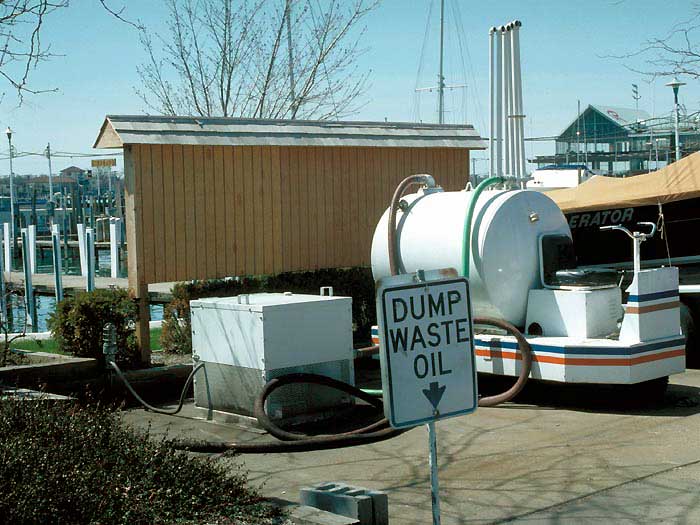Controlling Nonpoint Source Pollution
Pollution Tutorial

Sediment fences such as this one are used in urban and suburban areas and construction sites to control erosion, trap large materials, filter sediment from rainwater, and slow runoff.
While research, monitoring, and assessment look at the larger environmental effects of nonpoint source pollution, taking measures to stop pollution before it begins is also essential for controlling the problem. This is especially true in coastal communities where more than half of the U.S. population resides. If coastal populations continue to grow, the chances for more nonpoint source pollutants such as nutrients, sediments, pesticides, and other toxic chemicals to enter waterbodies via runoff increases.
Even though the exact locations of nonpoint source pollution cannot be identified, scientists know that certain environments and operations produce a high volume of pollution. Experts have developed systems to reduce and even eliminate pollution from these places. Listed below are some strategies that urban and suburban areas, agricultural operations, forestry operations, and marinas use to decrease nonpoint source pollution.
Urban and Suburban Areas

Similar to sediment fences, retaining fences are used to prevent contaminants from entering aquatic environments. This retaining fence was set up as part of a salt marsh restoration program in Staten Island, New York in 1993. The fence prevented contaminants in the sediment from making their way into the Arthur Kill Waterway while the project was underway.
-
Buffer strips are strips of grass located between and around impervious paving materials such as parking lots and sidewalks, and a body of water. The buffer strip absorbs soil, fertilizers, pesticides, and other pollutants before they can reach the water.
Retention ponds capture runoff and stormwater. Sediments and contaminants settle out of the water when they are trapped in the retention pond.
Constructed wetlands are a recent innovation in which an area is made into a wetland; the land is then used to slow runoff and absorb sediments and contaminants. The constructed wetland also provides habitat for wildlife.
Porous paving materials are used in parking lots and highways. The porous pavement allows rainwater and stormwater to drain into the ground beneath it, reducing runoff. In some cases, there is also a stone reservoir underneath the pavement to allow filtration of the water before it reaches the groundwater.
Sediment fences, or knee-high black fabric fences, are often used at construction sites to trap large materials, filter sediment out of rainwater, and slow runoff.
Grass planting and laying of straw around construction sites help reduce runoff and associated nonpoint source pollution.
Agricultural Operations
Buffer strips are planted located between a farm field and a body of water. The buffer strip absorbs soil, fertilizers, pesticides, and other pollutants before they can reach the water.
Conservation tillage involves leaving some crop residue from a previous harvest while planting a new crop. Less erosion occurs because the field is not plowed, and nutrients or pesticides are more likely to stay where they are applied.
Crop nutrient management involves applying fertilizers sparingly to prevent excess nutrient runoff. Prior to the growing season, farmers test the fields to ensure that nutrients are applied only as needed.
Beneficial insects can be used to control agricultural pests, reducing the need for pesticides. Common predators include ladybugs, praying mantises, and spiders, which feed on aphids, mites, and caterpillars. These natural predators help control infestations on valuable crops such as corn, soybeans, and tomatoes.
Forestry Operations
The location and design of roads and skid trails (temporary pathways used to shuttle logs out of the forest) are carefully planned prior to any logging operations. Skid trails are designed to follow the contour of the land and reduce erosion.
Buffer strips are maintained between logging operations and nearby streams, lakes or rivers.
Trees are replanted after logging to allow for regrowth and less erosion.
Marinas
Shutoff valves on fuel pumps on docks help limit spillage into the water.
Pump-out stations at marinas allow boaters to safely empty their sanitary systems without dumping wastes into the water.
Trash is placed in appropriate waste containers.

Pump-out stations at marinas such as this one allow boaters to empty their sanitary systems without contaminating the water.
Pollution Lessons
- Welcome
- A Brief History of Pollution
- Point Source
- Nonpoint Source
- Urban and Suburban Areas
- Agricultural Operations
- Atmospheric Inputs
- Forestry and Mining Operations
- Marinas and Boating Activities
- Nutrients
- Suspended Sediments
- Pesticides and Toxic Chemicals
- Bacteria, Viruses, and Trash
- Research, Monitoring, and Assessment
- Controlling Nonpoint Source Pollution
- What You Can Do
- References
- Roadmap to Resouces
- Subject Review (PDF)
Categories of Pollution
Pollutants from Nonpoint Sources
